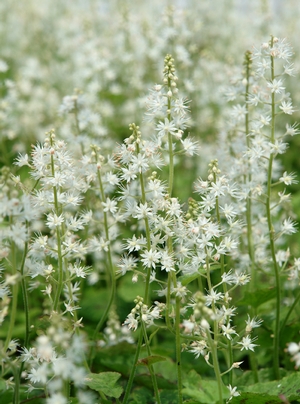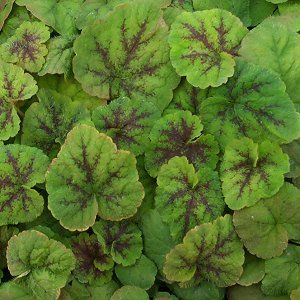Tiarella cordifolia 'Running Tapestry'
Common: foamflowerTiarella cordifolia 'Running Tapestry' LP32 - 32 per flat
- Height: 10"-12"
- Spread: 12"-18"
- Spacing: 12"
- Hardiness Zone(s): 4-8


Tiarella cordifolia 'Running Tapestry' LP32 - 32 per flat


A vigorous running groundcover with red speckled, deeply dissected heart shaped foliage, Tiarella 'Running Tapestry' produces a plethora of white flower spikes in spring. Discovered by Jim Plyler of Natural Landscapes Nursery, West Grove, PA, the irrepressible grower of native trees and shrubs. A Cornell University All Star Groundcover!
Tiarella 'Running Tapestry' prefers moist, rich, organic, well-drained soils in full to part shade. Do not let soil dry out. This foamflower is stoloniferous and quickly spreads. Makes an excellent groundcover or edging for shady or naturalized areas. Propogate by division in spring.
A vigorous running groundcover with red speckled, deeply dissected maple-like foliage, Tiarella cordifolia ‘Running Tapestry’ produces a plethora of white flower spikes in spring. Discovered by Jim Plyler of Natural Landscapes Nursery in West Grove, PA, ‘Running Tapestry’ quickly runs over the ground as it spreads by strawberry-like stolons. After a frost, Tiarella cordifolia picks up a lovely burgundy tinge, adding multiple seasons of interest beyond its spring flowering.
Tiarella cordifolia is found in shaded forests, swamps, and wetland margins from Ontario to Minnesota to Tennessee to Georgia. The variant species Preferring consistently moist, humus-rich soil, foamflower does not like soil drying out or sitting in saturated soils during winter. With no serious pest or disease issues, T. cordifolia does best if planted en masse and spreads rapidly by runners.
Foamflower is a powerful and natural partner in a shade garden embracing spring ephemerals and graceful sedges. We love weaving it along border fronts, naturalistic plantings, shaded rock gardens, or in woodland gardens. A fresh groundcover, even as other items in the woodland garden begin to look tired in the summer, Tiarella cordifolia provides texture and color all year long. The foliage is astringent, usually deterring rabbits and deer from grazing unless they are extremely hungry. Early-season pollinators visit foamflower while other plants are still waking up in the spring.